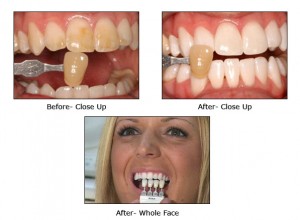Types of Teeth Whitening
Custom fit tray bleaching (in-home)
A small amount of the bleaching gel is placed in a custom fitted tray and worn for a brief amount of time each day for a week. This is a common technique because it’s easy to use and is cost efficient.
Impressions are taken of your mouth and a thin custom tray is made to fit your teeth which you take home. We offer two types of gels of different ingredients, one which is faster acting and one which is slower acting. The trays are to be worn up to 4 hours a day depending on which gel you use.
While some results may be seen in a couple days, it usually takes one to two weeks to see the full whitening of your teeth.

Cost
The cost of whitening trays is $710 and includes the two custom trays as well as your first lot of bleaching gel. The trays should last a minimum of 10 years if well looked after.
After you have run out of gels, a top up kit can be purchased yearly for $90
Main Benefit
The custom made trays could last forever so once made, there is a low yearly cost to keep your teeth white for the rest of your life.
Example:
-

Before -

After
Power whitening (in-office) – ZOOM whitening
(We no longer offer this option as we found that the results were too short acting and patients often suffered too much pain; the take home trays offer a superior result that lasts longer.)
ZOOM whitening uses a special light with a whitening gel. These are in-office bleaching systems. It is often followed up with an at-home bleaching kit if needed.
FAQs
Q: What is tooth whitening?
A: Tooth whitening, also known as bleaching, uses various processes to lighten your teeth from their original color to a brighter, whiter smile. Reasons people have their teeth whitened are either to get rid of stains or simply for a whiter color.
Q: How does tooth whitening work?
A: Most tooth whitening materials have a peroxide ingredient. When this agent comes into contact with water it releases hydrogen peroxide, which then lightens the color of the teeth.
Q: Is tooth whitening safe? Does it have any side effects?
A: Tooth whitening has been shown to be a safe and effective method of getting whiter teeth in many studies done over the years. Tooth whitening products have garnered the seal of approval from the American Dental Association (ADA).
The only side effects people may encounter are minor gum irritation or tooth sensitivity, which should disappear at the end of the treatment.
Q: What causes tooth discoloration?
A: The enamel covering of the tooth can become discolored from things such as:
- Cigarettes
- Coffee
- Some Medications
- Tea
- Genetics
- The aging process causes teeth to discolour from the inside
Q: What makes a good tooth whitening candidate?
A: Ninety percent of people or more make good candidates for tooth whitening. However, if your stains were caused by flourosis or tetracycline, you may get lighter teeth, but the results generally aren’t as striking compared to the results on other types of stains.
You may not be considered a good candidate for tooth whitening if you have:
- Extremely sensitive teeth
- Periodontal (gum) disease
- Worn enamel on your teeth
Q: How long do whitening results last?
A: There is no definite answer because each whitening patient is different. Factors that can cause differing lengths of results include your heredity and how many staining foods and drinks you consume following treatment. A lot of whitening patients can see results last anywhere from one to three years without needing major touchups. If you want longer lasting results, Composite Veneers are an alternative that can give you a whiter smile for a much longer period of time.
Q: What results can I expect with tooth whitening?
A: Because everyone is different, there is no way to tell for sure how much lighter you teeth will get. You can usually expect at least a two-shade improvement from your original coloring. However, the amount of whitening achieved also depends on what type of stains or discoloration you have and how well you follow the dentist’s orders. If your teeth are gray, for example, you will probably only achieve a lighter shade of gray. Also, whitening does not work on artificial dental materials in your mouth such as resin, composite, or porcelain.
Q: What about over-the-counter whitening products?
A:People often tell us that they aren’t satisfied with over-the-counter whitening products’ results. By definition over the counter products have to be safe even when abused, this means that many of the active ingredients have to be removed. People generally get better results with in-office whitening or dentist-supervised home treatments.